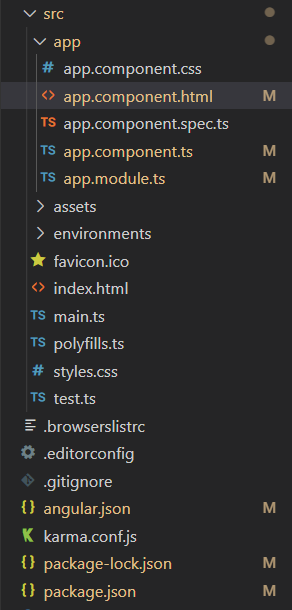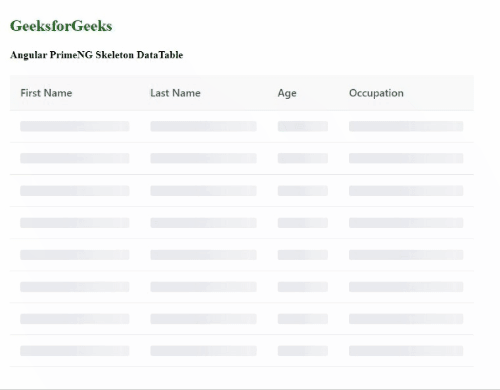Angular PrimeNG Skeleton数据表
Angular PrimeNG是一个开源的前端UI库,它有许多原生的Angular UI组件,可以帮助开发人员建立一个快速和可扩展的网络解决方案。在这篇文章中,我们将看到Angular PrimeNG SkeletonDataTable.
当实际组件的数据在后台加载时,Skeleton组件是作为一个占位符使用的。为了显示一个Skeleton数据表,我们可以在表的主体模板中用p-skeleton组件替换列数据。
语法:
<p-table [value]="..." responsiveLayout="scroll">
<ng-template pTemplate="header">
<tr>
....
</tr>
</ng-template>
<ng-template pTemplate="body" let-x>
<tr>
<td>
<p-skeleton></p-skeleton>
</td>
<td>
<p-skeleton></p-skeleton>
</td>
....
</tr>
</ng-template>
</p-table>
创建Angular应用程序并安装模块:
第1步:使用以下命令创建一个Angular应用程序。
ng new appname
第2步:创建你的项目文件夹即appname后,使用以下命令移动到它。
cd appname
第3步:最后,在你给定的目录中安装PrimeNG。
npm install primeng --save
npm install primeicons --save
项目结构:在完成上述步骤后,项目结构将看起来像这样。

Project Structure
运行下面的命令来运行该应用程序。
ng serve --open
例子1:这是一个基本的例子,说明如何显示一个有2列3行的Skeleton数据表格。
<div
class="page-content"
style="height: calc(100vh - 149px)">
<h2 style="color: green">GeeksforGeeks</h2>
<h4>Angular PrimeNG Skeleton DataTable</h4>
<p-table [value]="tableData" responsiveLayout="scroll">
<ng-template pTemplate="header">
<tr>
<th>First Name</th>
<th>Last Name</th>
</tr>
</ng-template>
<ng-template pTemplate="body" let-product>
<tr>
<td>
<p-skeleton></p-skeleton>
</td>
<td>
<p-skeleton></p-skeleton>
</td>
</tr>
</ng-template>
</p-table>
</div>
import { Component } from '@angular/core';
interface People {
firstname?: string;
lastname?: string;
}
@Component({
selector: 'app-root',
templateUrl: './app.component.html',
})
export class AppComponent {
tableData: People[] = [];
constructor() { }
ngOnInit() {
this.tableData = [
{
firstname: 'Varun',
lastname: 'Pratap',
},
{
firstname: 'Badal',
lastname: 'Mishra',
},
{
firstname: 'Abhishek',
lastname: 'Thakur',
}
];
}
}
import { NgModule } from '@angular/core';
import { BrowserModule } from '@angular/platform-browser';
import { FormsModule } from '@angular/forms';
import { BrowserAnimationsModule }
from '@angular/platform-browser/animations';
import { AppComponent } from './app.component';
import { TableModule } from 'primeng/table';
import { SkeletonModule } from 'primeng/skeleton';
@NgModule({
imports: [
BrowserModule,
BrowserAnimationsModule,
TableModule,
FormsModule,
SkeletonModule
],
declarations: [AppComponent],
bootstrap: [AppComponent],
})
export class AppModule { }
输出:

例子2:这是另一个例子,展示了如何在Angular PrimeNG中使用一个Skeleton数据表格。这里我们有4列和8行。
<div
class="page-content"
style="height: calc(100vh - 149px)">
<h2 style="color: green">GeeksforGeeks</h2>
<h4>Angular PrimeNG Skeleton DataTable</h4>
<p-table [value]="tableData" responsiveLayout="scroll">
<ng-template pTemplate="header">
<tr>
<th>First Name</th>
<th>Last Name</th>
<th>Age</th>
<th>Occupation</th>
</tr>
</ng-template>
<ng-template pTemplate="body" let-product>
<tr>
<td>
<p-skeleton></p-skeleton>
</td>
<td>
<p-skeleton></p-skeleton>
</td>
<td>
<p-skeleton></p-skeleton>
</td>
<td>
<p-skeleton></p-skeleton>
</td>
</tr>
</ng-template>
</p-table>
</div>
import { Component } from '@angular/core';
interface People {
firstname?: string;
lastname?: string;
age?: number;
occupation?: string;
}
@Component({
selector: 'app-root',
templateUrl: './app.component.html',
})
export class AppComponent {
tableData: People[] = [];
constructor() { }
ngOnInit() {
this.tableData = [
{
firstname: 'Varun',
lastname: 'Pratap',
age: 20,
occupation: "Student"
},
{
firstname: 'Badal',
lastname: 'Mishra',
age: 21,
occupation: "Engineer"
},
{
firstname: 'Abhishek',
lastname: 'Thakur',
age: 23,
occupation: "Businessman"
},
{
firstname: 'Karan',
lastname: 'Patel',
age: 19,
occupation: "Sportsman"
},
{
firstname: 'Pallavi',
lastname: 'Yadav',
age: 20,
occupation: "Student"
},
{
firstname: 'Abhinav',
lastname: 'Yadav',
age: 21,
occupation: "Software Developer"
},
{
firstname: 'Abhay',
lastname: 'Rathore',
age: 23,
occupation: "Intern"
},
{
firstname: 'Abhishek',
lastname: 'Kumar',
age: 34,
occupation: "Doctor"
},
];
}
}
import { NgModule } from '@angular/core';
import { BrowserModule } from '@angular/platform-browser';
import { FormsModule } from '@angular/forms';
import { BrowserAnimationsModule }
from '@angular/platform-browser/animations';
import { AppComponent } from './app.component';
import { TableModule } from 'primeng/table';
import { SkeletonModule } from 'primeng/skeleton';
@NgModule({
imports: [
BrowserModule,
BrowserAnimationsModule,
TableModule,
FormsModule,
SkeletonModule
],
declarations: [AppComponent],
bootstrap: [AppComponent],
})
export class AppModule { }
输出:

 极客教程
极客教程